Ralph Paine – 15 June, 2015
Amidst all the junkspace paraphernalia and geek-graphics of Denny's Library fit out there's a fiery-eyed ‘n' silver replica head of that shape-shifting demon machine the Terminator itself. By the end of 'Terminator 3: Rise of the Machines' Kate Brewster and John Connor have escaped to the confines and safety of a 1950s nuclear fallout shelter deep inside a multi-tunnelled military base named Crystal Mountain. While Judgement Day rages outside, using the emergency shortwave radio equipment in the shelter they begin talking to other members of a fledgling resistance movement now safe inside other fallout shelters scattered throughout North America.
Venice
Simon Denny
Secret Power
9 May - 22 November 2015
The things of this world reveal their essential absurdity when they are put in the Venetian context. In the unreal realm of the canals, as in a Swiftian Lilliput, the real world, with its contrivances, appears as a vast folly.
- Mary McCarthy, Venice Observed
A while back on this site I posted a comment declaring that “I’d rather go to an electronics shop at the fucking mall than visit any Simon Denny exhibition. Or stay home all afternoon watching back-to-back episodes of American Dad on the BIG SCREEN TV. Or lie in some forest somewhere listening to ULTRAVIOLENCE playing on my new iPod, real real loud in the sleek white headphones.” (1) Too bad and never mind. Here I’m going to eat these words, because right now I’d really like to get on a plane and go visit Simon Denny’s Secret Power exhibition in Venice.
So why the sudden change of heart? The discussion on said comments thread centred on notions of discourse and context - art-as-discourse, art-as-context - all in response to Terrence Handscomb’s review of Denny’s 2014 exhibition The Personal Effects of Kim Dotcom at Adam Art Gallery. Also in the thread I wrote this: “Artists do not seek or create disruption. What artists seek or create is DIRECT DISCOURSE. They want to discover the PASS-WORD beneath the order-word, to extract an autonomous Self from behind the subjected I - they want to speak in tongues. And they do this by detaching things, signs, fragments, words, etc. from the given collective assemblage, from all apparent social determination, and re-presenting them as radically xenoglossic beings.” (2) I get it now, but back when I wrote them I didn’t realise that these words are a perfect description of Denny’s modus operandi. Yes, Denny’s work speaks in tongues; yes, he creates radically xenoglossic beings in the manner described.
No need here to grapple with what was distorting my vision. Suffice it to say that Denny and I share certain K Road art-scene vibes and connections that go way back and run perhaps a little too deep. No, there’s a more important issue at hand, and that’s the problem of how to write about Secret Power from afar - remotely as it were - without my having experienced its two Venetian locales in situ. With its multiple references and links to computers, the Internet, global surveillance, etc. there’s no doubt that the nature of Denny’s project lends itself to vision-at-a-distance. But to an exponentially increasing extent it’s also the case that contemporary art itself - and thus contemporary art writing - is conditioned by the same vision. Hence: the conditions of possibility (conditioning conditions/conditioned conditions) in and through which contemporary art is produced are digital and photographic. In this sense, contemporary art is not simply art made “now.” Rather, it is art that (technically, aesthetically, conceptually, etc.) explores, poeticises, experiments with, or even attempts to escape from, the digital and photographic distances and complexes that more and more of us today occupy and move within. (3)
Not however that the digital and the photographic exhaust the possibilities - many other terms and conditions apply. I’ve heard Denny speak in interviews of his engagement with the history of conceptual art. In Anywhere or Not at All: Philosophy of Contemporary Art, Peter Osborne states: “contemporary art is postconceptual art,” (4) meaning that if conceptual art was an anti-aesthetic intent on removing the pre-eminence of materialised affect and sensation from art and instead awarding primacy to “ideas,” contemporary art returns to materialised affect and sensation but retains the aesthetic consequence of ideas. Osborne’s assertion is premised on a rewriting of the history of modern art and aesthetics, a rewriting, inspired in the main by Benjamin and Adorno, which draws a distinct line running from the Jena Romantics through Duchamp and one strain of the Russian Constructivists, to Dada, Surrealism, Fluxus, and conceptual & minimalist art. Osborne begins in Germany, just after the French Revolution, with a modification/correction conducted by Schelling on Kant’s and Baumgarten’s aesthetic theories. This modification/correction someway concerns how it is possible to make distinctions between an aesthetic realm in general (Ancient Greek sense) and an aesthetic realm in the (modern) artistic sense.
In brief, Osborne’s line is one that negates or avoids all notions of a medium specific modernism; it derives art’s autonomy not from the status of an entirely separate sphere but from ongoing tensions operative between art and non-art; it insists that anything can be art, to infinity; it conceives of contemporary art as emphatically distributive, meaning that the “unity” of an artwork is spread across its multiple manifestations, and this includes across historical time; and, there is an instigating conceptual consequence on the line favouring fragments, projects, series, and “transdisciplinarity.”
For Osborne, the Master Instigator of contemporary art is Robert Smithson: yes, the “site/non-site dialectic” is where it’s all at - it’s the ne plus ultra of postconceptual art. I agree, but Osborne goes nowhere near the isomorphic beast entropy/information, and thus he avoids dealing with the heavy-shit problems of cybernetics and control as frequently displayed and dramatised in Smithson’s work. In my view it’s crucial these problems be added as conditions of contemporary art. (5) Whatever, but given the above, Denny’s Secret Power project is exemplary: the digital and the photographic, cybernetics and control, postconceptuality, tensions operative between art and non-art, transdisciplinarity, site/non-site dialectics… The project is resplendent in contemporary possibility. Or to speak like Leibniz, Secret Power is big with the future.
As if arriving from out of this future - and with the aid of flythetube (6) - I descend now over the industrial complexes of Porto Maghera, the Via Libertá causeway, a sparkling blue-fractal Lagoon, and land smoothly at Venice’s Marco Polo Airport. Inside the terminal building, on the floor and on wall panels, on baggage claims, Denny has installed large sectioned reproductions of the ceiling and walls of the Monumental Rooms at Marciana Library in Piazza San Marco - plus framed and wall-mounted copies of maps selected from the Library’s vast historical collection. Via websites and Facebook pages I do a virtual stroll across simulacra of works by Tintoretto, Titian, Veronese… All digitalised painted allegory - Music, Arithmetic and Geometry, Honour, Wisdom, Arms - the Venetian School as tourist art, tondi of grounded sky, coastlines, continents, Art History 101 on moving conveyor belts, backdrop and stage in a theatre of security staff, airline personnel, immigration officers, and jet lagged tourist-pilgrims.
Provisionally, the Arrivals Zone at Marco Polo Airport is Secret Power‘s non-site, the Marciana Library its site. A non-site marks an actual elsewhere. A non-site is a 3D “logical picture” of a site, i.e. its abstracted “no place”. Sculptural and architectural, the wrap-around feel of Denny’s Arrival Zone imagery fits the idea of 3D abstraction well. Smithson: “[…] the Non-Site itself exists [as] a space of metaphoric significance. It could be that ‘travel’ in this space is a vast metaphor. Everything between the two sites could become physical metaphorical material devoid of natural meanings and realistic assumptions. Let us say that one goes on a fictitious trip if one decides to go to the site of the Non-Site. The ‘trip’ becomes invented, devised, artificial; therefore, one might call it a ‘non-trip’ to a site from a Non-Site […]” (7)
But already the Library/Airport relation is vectored-in on a global network of multiple other site/non-site connections. Installing simulacra of the Marciana Library inside Venice’s airport terminal rigs an inspired relation between the two locales. It also inserts this relation within a space of “invented, devised, artificial” connectivity named Airspace. Here at the Terminus, before crossing the Lagoon and entering the sublime city Mary McCarthy once called “the unreal realm of the canals,” (see my epigraph) Denny relays me the warped-metaphoric idea that today the earth itself is encircled by its own unreal realm of “canals,” i.e. flights that are really non-flights, digitally coded air routes, radar signals, satellite pathways, automated tele-vectors, surging streams of beautiful data, information flow - “a vast folly” to be sure.
For my final passage - from the Santa Lucia Train Station, across foot bridges and through labyrinthine alleyways to Piazza San Marco - memory serves me well. Twice I’ve spent time in Venice, and recollection comes easy - it’s that kind of place. First time there, in the northern summer of 2001, I was in search of works by my since-childhood obsession the painter Giovanni Battista Tiepolo. But my vaporetto rides and wandering took me all over, including to Renaissance architect Jacopo Sansovino’s exquisite Marciana Library. Lately I’ve taken to revisiting the famous building, courtesy of state-of-the-art nzatvenice (8) and a bunch of touristy-architectural websites. And of course already on media websites there’s a superfluity of remarkable commentary and review concerning the Monumental Rooms section of the project. No real need then to recount this chapter of the Secret Power back-story; to speak of Nicky Hagar and his 5 Eyes book, of WikiLeaks and Snowden’s stolen files, or the David Darchicourt connection and Denny’s subsequent commissioning of graphics from the geeky NSA design operative turned freelancer. I’m as super-intrigued as anyone by the whole Net Wars Total Surveillance<< >>Total Encryption thing, and like some others I figure Secret Power as a brilliant tactical manoeuvre against Leviathan - but hey, the exhaustive details have been exhaustively detailed.
Meanwhile, with its gleaming rows of museum-like “modded sever-rack display cases,” its blue earth-globe suspended in rope from the talons of a taxidermied eagle, the pop/commonplace paraphernalia, the aforementioned paintings, etc. Denny’s Library is coming on now as pure Marcel Broodthaers, totally Museum of Modern Art, Department of Eagles, 1968-71. Broodthaers is another Master Instigator of postconceptual art and I get the feeling that Denny is paying wonderful homage here, honouring-up to past archive art and the history of institutional critique: Secret Power channels and re-historicises an amazing conceptual and artistic espirit de corps as enquiry into the relation of signs, writing, and political power… Scientia est potentia could be the project’s motto for sure.
Ok then: signs and writing enable the keeping of records, yet by acting as a semiotisation of activity they also enhance command, facilitating orders and the law: a city-state will require archives. Deriving from the ancient Greek arkhé - here I’m following Jacques Derrida - the word archive holds together two meanings: commencement (first principle, there where things begin); and commandment (from where order is given, there where men and gods have authority). An archive is thus a “place,” a built site of the city-state, “a house, a domicile, an address, the residence of the superior magistrates,” whose function it is to be in charge of the storage and protection of the city-state’s “documents.” As such, the magistrates are guardians of the archive, keepers of the law. But at the same time, they are accorded the special “right and competence” of interpreting it. The magistrates give the archive a meaning and an order, they play a hermeneutic role, i.e. they produce the truth: “It is thus, in this domiciliation, in this house arrest, that archives take place.” (9)
Echoing Derrida, Michel Foucault in The Archaeology of Knowledge affirms that “the archive is first the law of what can be said, the system that governs the appearance of statements as unique events,” (10) i.e. founding events. Foucault’s aim in The Archaeology is to determine how an archive produces political effects. He wants to construct a vital link between power and knowledge; to conceive of how power and knowledge become articulated. Again, an archive is not simply an amorphous dust-collecting body of books, documents, photographs, maps, ledgers, and objects. Rather, an archive is transformative and reproductive, partaking in the very determination of what is sayable and what can be made visible within any particular historical assemblage (regime of signs). An archive “is that which defines the mode of occurrence of the statement-thing; it is the system of its functioning.” The system has two sides, its discursive formation and its non-discursive formation, sayability and visibility, language and light. An archive functions by bringing together particular combinations of the two in order to create and impose power/knowledge effects on the built spaces of the city-state and on the lives of its populace. Hence the archive’s transformative and reproductive quality, its ability to code, decode, recode.
In Foucault, Deleuze tracks this notion of an archive-function from its theoretical inception in The Archaeology through to its eventual precision and procedural breadth in Foucault’s Discipline and Punish as “the Diagram.” (11) In the earlier text, Foucault placed an emphasis on the link between discourse and power, while in the later a modern and more abstract articulation is theorised through a singular power of making visible. Foucault’s famous example is the Panopticon, Jeremy Bentham’s nineteenth century plan for an all-seeing architecture that would come to act as the idealised model for such modern institutions as the prison, workshop, school, and hospital: “This Panopticon, subtly arranged so that an observer may observe, at a glance, so many different individuals, also enables everyone to come and observe any of the observers. The seeing machine was once a dark room into which individuals spied; it has become [in modernity] a transparent building in which the exercise of power may be supervised by society as a whole.” (12)
The Panopticon, like all diagrams of this sort, is “intersocial and constantly evolving. It never functions in order to represent a persisting world but produces a new kind of reality, a new model of truth.” When Deleuze describes such diagrams as “abstract machines” what he means is that they function as “immanent causes,” i.e. causes coextensive with the concrete socio-technical assemblages that “execute [their] relations.” Yet these relations - precisely because they are expressed diagrammatically - are “merely virtual, potential, unstable, vanishing and molecular,” and thus constantly giving realisation to assemblages and functions which integrate the Diagram in new and ever expanding ways. And this process - initially local - tends towards integration at the global level. Today the Panopticon invades and transforms the whole of the social field. At the global level, the Diagram is networked and in-business 24/7.
Julian Assange: “Shrouded in secrecy, swallowed up by complexity and scale, the world is hurtling towards a new transnational electro-dystopia […] Localisation doesn’t matter that much. The Chinese internet model and the American giant server farms are proof of the dangerous fact that digital automation is inherently coupled with the efficiencies of centralisation and control.”(13)
Amidst all the junkspace paraphernalia and geek-graphics of Denny’s Library fit out there’s a fiery-eyed ‘n’ silver replica head of that shape-shifting demon machine the Terminator itself. (14) By the end of Terminator 3: Rise of the Machines Kate Brewster and John Connor have escaped to the confines and safety of a 1950s nuclear fallout shelter deep inside a multi-tunnelled military base named Crystal Mountain. While Judgement Day rages outside, using the emergency shortwave radio equipment in the shelter they begin talking to other members of a fledgling resistance movement now safe inside other fallout shelters scattered throughout North America. A secret network of communication is being established, but this via an old technology which the 100%-digitalised SkyNet Corporation cannot utilise or decipher. Against the Accelerationists, there’s something alluring about the idea that the Apocalypse has already happened and now comes our slow circling-back.
Ralph Paine
(1) http://eyecontactsite.com/2014/11/politics-without-the-revolution
(2) For an account of “speaking in tongues” and the term “xenoglossic” see Gilles Deleuze and Felix Guattari, “November 20, 1923 - Postulates of Linguistics,” A Thousand Plateaus: Capitalism and Schizophrenia, trans. B. Massumi, Minneapolis & London: University of Minnesota Press, 1987.
(3) I use both terms in a general sense. The term “photography” would thus encompass everything from the camera obscura through to cinema, video, and Google Earth; and the term “digital” include its myriad philosophical nuances and complexities along with its omnipresent computer-based uses. On photography as a condition of contemporary art see Peter Osborne, Anywhere or Not at All: Philosophy of Contemporary Art, London & New York: Verso, 2013. On information and the digital from a philosophical point of view see the later writings of Gilles Deleuze - especially the sections on the analogue vs. the digital in Francis Bacon: The Logic of Sensation, trans. D. W. Smith, London & New York: Continuum, 2003; the essays “Postscript on the Society of Control,” and “Having an Idea in Cinema: On the Cinema of Straub-Huillet;” and Foucault, London & New York: Continuum, 1999. For an amazingly vital recent analysis of both the photographic and the digital see Alexander R. Galloway, Laruelle: Against the Digital, Minneapolis & London: University of Minnesota Press, 2014.
(4) Peter Osborne, Anywhere or Not at All, p. 3. Emphasis in the original.
(5) See Ralph Paine, “My Empire of Dirt: Smithson, Deleuze and Guattari,” Z/X#4: Journal of Manukau School of Visual Arts, 2008.
(6) https://www.youtube.com/watch?v=CkG8YBPDcss
(7) http://www.robertsmithson.com/essays/provisional.htm
(8) http://www.nzatvenice.com
(9) Jacques Derrida, Archive Fever: A Freudian Impression, trans. E. Prenowitz, Chicago & London: The University of Chicago Press, 1996, p. 2.
(10) Michel Foucault, The Archaeology of Knowledge; and The Discourse on Language, trans. A. M. Sheridan Smith, New York: Pantheon, 1982, p. 129.
(11) Gilles Deleuze, Foucault, p. 34.
(12) Michel Foucault, Discipline and Punish: The Birth of the Prison, trans A. Sheridan, London and New York: Penguin, 1979, p. 207.
(13) As quoted in John Keane, “Why Google is a Political Matter: A Conversation with Julian Assange,” The Monthly: Australian Politics, Society & Culture, June 2015. Emphasis added.
(14) “Politics has become manifesto by Photoshop, seamless blueprints of the mutually exclusive, arbitrated by opaque NGOs. Comfort is the new Justice. Entire miniature states now adopt Junkspace as political program, establish regimes of engineered disorientation, instigate a politics of systematic disarray. Not exactly ‘anything goes’; in fact, the secret of Junkspace is that it is both promiscuous and repressive: as the formless proliferates, the formal withers, and with it all rules, regulations, recourse … Babel has been misunderstood. Language is not the problem, just the new frontier of Junkspace.” Although architectural in spirit, in my view Rem Koolhaas’ way-cool concept “junkspace” is another essential ingredient in the contemporary art recipe. See http://lensbased.net/files/Reader2012/rem+koolhaas+-+junkspace.pdf
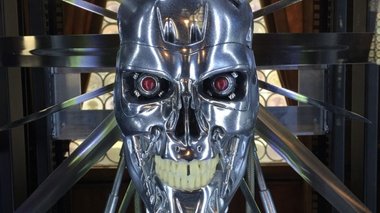
 Advertising in this column
Advertising in this column Two Rooms presents a program of residencies and projects
Two Rooms presents a program of residencies and projects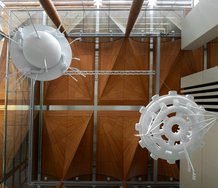
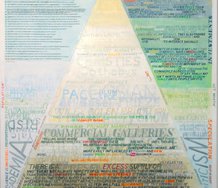
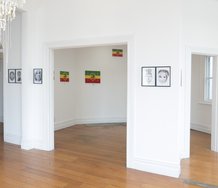
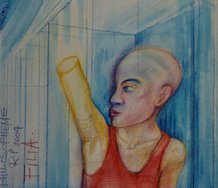
This Discussion has 0 comments.
Comment
Participate
Register to Participate.
Sign in
Sign in to an existing account.